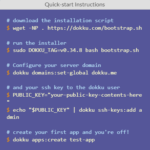
Today’s rapidly evolving technological landscape combined with challenging economic conditions, complex contracts, and service-level agreements can hinder a business’ ability to evolve and adapt. This also creates an environment where application development and management (ADM) requirements are constantly changing.
The upside of this challenging environment is that it creates an opportunity for companies to proactively navigate and actively manage their ADM processes. As organizations explore different ways to utilize and improve their ADM services, they should prioritize a strategic, simple, and sustainable roadmap.
Enhance strategic decision-making: By adopting a strategic ADM approach, enterprises can reduce costs and achieve better outcomes that are aligned with their business goals and objectives. In addition, they will improve the efficiency and the effectiveness of your application development and management efforts. Focusing on the following five key principles and practices will help your enterprise achieve desired strategic outcomes:
Align your ADM portfolio with your business goals: Be clear on your business outcomes prior to reviewing the applications that are currently in use and the purposes they serve. Once the applications portfolio is reviewed, organizations should assess how well each application aligns with the identified business goals. This can be done by evaluating the application’s functionality, usage, and benefits to the organization.
Focus on the most important applications that drive business outcomes: Not all applications are equally critical to the organization’s success. Emphasize your ADM efforts on the applications that are most essential to achieving business goals and delivering value to stakeholders.
Foster a culture of innovation: ADM can support the development of new products and services, or the introduction of new business models by providing the tools and infrastructure needed to enable innovation.
Increase concentration on data and analytics: Data is becoming increasingly complex and diverse for which a well-designed ADM framework will process and manage this data efficiently and accurately. Collecting, processing, and analyzing data from a variety of sources is essential for effective data analysis.
Choose a partner that is aligned with your strategy: Don’t overcomplicate the setup and business KPIs. Ensure your partner is well versed in all aspects of applications and evolving technologies.
Keep the execution simple and straight forward
Once the ADM strategy is defined, implementation can begin. A popular design principle states that designs and/or systems should be simple and feasible. Complexity should be avoided whenever possible in a system, as simplicity ensures the highest degree of user acceptability and interaction. Businesses can streamline the ADM process and reduce unnecessary complications by taking the following actions:
Adopt a flexible and agile approach: These methodologies emphasize iterative and incremental development, allowing for flexibility in adapting to changing requirements and priorities and for frequent and smaller releases, reducing the risk associated with large deployments.
Utilize low code-no code platforms: Low-code and no-code platforms provide visual interfaces and pre-built components that allow developers and even non-technical users to quickly build applications, which speeds up the application development process and reduces the reliance on traditional coding, enabling faster time to production.
Communicate clearly and regularly: Organizational Change Management (OCM) plays a vital role in implementing changes associated with ADM. Clear and regular communication ensures alignment, manages expectations, and fosters collaboration.
Focus on user needs and prioritize user experience: Adopt a user-centered design approach during application development. Conduct user research, gather feedback, and understand user requirements and pain points. Incorporate user feedback into the design and development process to ensure that the application meets their needs and provides an intuitive user experience.
Increase use of automation and artificial intelligence: Strategically automation and AI tools bring numerous benefits, including improved efficiency, scalability and quality. With technologies evolving quickly, it’s important to choose a partner that strikes a balance and identifies areas where automation and AI can bring the most value, while still maintaining human oversight and ensuring ethical considerations. Regular monitoring, evaluation, and continuous improvement are essential for successfully implementing automation and AI in ADM.
Choose the right partner with vital experience: You can select a strategic service provider or partner that aligns with your organization’s goals, expertise requirements, and cultural fit, ultimately contributing to the success of your ADM initiatives by evaluating several factors. These factors include cultural fit, proven experience level, industry reputation and references, service offering alignment, security and compliance, innovation and future readiness, and cost and value.
Adopt a sustainable approach
The last pillar is creating an ADM blueprint that will reduce the environmental impact with sustainable development practices. Enterprises should consider leveraging the approaches below to implement sustainable solutions and stay ahead of competition.
Optimize code for energy efficiency: Your company or strategic partner can design and code applications with energy efficiency and sustainability in mind. These strategies, which range from optimizing the user interface to efficient data storage and processing, contribute to reduced energy consumption, lower carbon footprints, and a more environmentally friendly approach which is an essential aspect of promoting sustainability.
Remote work: By developing applications that support remote work, organizations enhance sustainability by reducing carbon emissions, office space requirements and paper waste. These applications enable employees to work securely and efficiently from anywhere, fostering work-life balance and environmental responsibility.
Cloud migration: Migrating applications to the cloud reduces infrastructure costs and energy consumption, optimizes resource usage, and increases scalability. It is important that the environmental practices of cloud providers assess the sustainability benefits of the migration and optimize applications for efficient resource usage.
Providers that prioritize sustainability: Choose providers that have policies in place to reduce their environmental impact, consider their commitment to sustainability and energy-efficient practices including partners who prioritize energy-efficient infrastructure, green computing, and sustainable operations.
Leverage automation tools: Organizations enhance efficiency, optimize resource usage, and reduce energy consumption by utilizing automation tools to improve application testing, deployment, and monitoring. This approach promotes sustainability by minimizing waste, improving operational effectiveness, and reducing the environmental impact.
Creating and maintaining a strategic, simple, and sustainable ADM environment within your enterprise opens a significant opportunity to continuously optimize your overall program. By aligning ADM efforts with business goals, simplifying processes, and adopting sustainable practices, your organization can make better use of resources, respond to changes swiftly, and achieve leaner operations. This drives continuous improvement, enhances the effectiveness of your program, and ultimately contributes to the success of your ADM endeavors.







